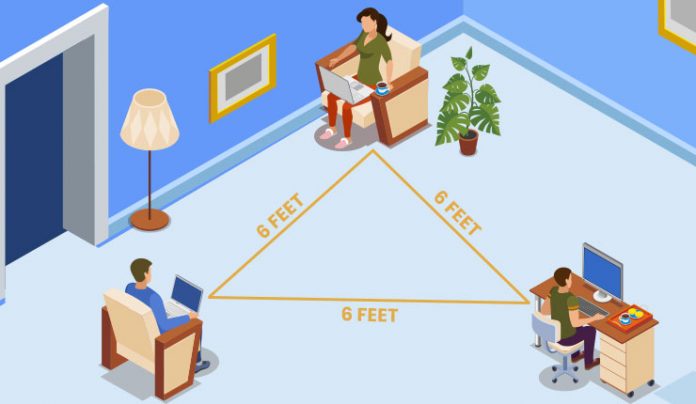
With the number of COVID-19 cases increasing every day, doctors and scientists offer insights on how to separate yourself from others, while still getting the social support you need.
WHO and other medical bodies around the world are constantly updating our knowledge about COVID-19 due to the ongoing research of this new virus. One of the major preventive guidelines is that we must maintain 6 feet distance from others to ensure safety. When someone coughs, sneezes, or speaks they spray small liquid droplets from their nose or mouth which may contain viruses. If you are too close, you can breathe in the droplets, including the COVID-19 virus if the person has the disease.
However, now it has been found that standing 6 feet away from others may not actually ensure safety. More than six months into the pandemic, there is talk of reexamining the 6 feet social distancing guideline. Experts point to evidence that the virus can remain in the air for hours and travel distances much greater than 6 feet. Factors such as crowd density, ventilation, face masks, and whether people are silent, speaking, shouting, or singing should all be considered in assessing distance.
A team of infectious-disease experts argues in a new analysis that six-feet protocols are too rigid and are based on outmoded science and observations of different viruses. Other researchers say six feet is a start — but only a start, warning that more space is almost always better, especially in poorly ventilated areas indoors.
University of Nebraska researchers found that the virus can be infectious in distances much farther than the 6 feet social distancing guidelines. An air sampling study, published in late July, found enough virus floating near the rooms of patients with covid-19, the disease caused by the coronavirus, at the University of Nebraska Medical Center, including in hallways, for scientists to grow the pathogen in cell cultures. Another study found living virus up to 16 feet away from covid-19 patients at a hospital in Gainesville, Fla.
Scientists have warned that certain areas like indoors or areas with poor airflow, un-masked people infected with COVID-19 can transmit the virus through an airborne route via so-called aerosols,” Dr. Benjamin D. Singer, a critical care physician at Northwestern Medical Group in Chicago “These particles can hang in the air and transmit over distances greater than 6 feet.” Indoors, both proper distance and wearing a mask are imperative.
If the novel coronavirus can float in the air as a vapor, earlier assumptions of its range are inadequate. Airborne transmission is still not conclusively proven, but a growing number of experts see persuasive evidence in super-spreading events that have transmitted the virus to people scores of feet away from the infection source.
One helpful analogy is the cloud from a cigarette smoker. As you move farther away, you’re exposed to less because it becomes more diluted. The smoke doesn’t stop, though, at six feet.
Experts still recommend wearing surgical or cloth masks to protect against the virus. Only masks recommended for blocking this virus should be used. There are many fancy masks available in the market. One needs to be sure that the mask protects you from the virus in indoor areas and places where a large number of people may be present.
Many countries have allowed opening of malls and restaurants. These places are frequently visited by a large population. Restaurant indoors remains risky because ventilation is poor, and people are eating with their masks off. One needs to be very careful about such places, maintain sufficient distance and the restaurants need to carry out routine sanitation of frequently touched surfaces.
Outdoor gatherings with family and friends are deemed as safe as long as family members stick together and observe physical distancing from other groups. Washing hands or using hand sanitizer is highly recommended.
Riding in elevators if they are not crowded, and shopping for groceries as long as you mask up, are permissible. But using public transport and not observing more than 6 feet distance is highly dangerous. This is primarily because of a large crowd, poor circulation and transit time.
Gyms and bars also present health hazards. While exercising people are breathing hard in gyms that often have poor circulation. They also remove masks during exercising due to inconvenience in breathing fast through masks. Bars serve alcohol that may cloud social distancing judgment, said the experts.
It is highly unlikely that schools and colleges would be allowed to function in the near future. Children may not follow more than six feet social distancing and wear masks all the time. This may actually result in spreading disease through them.
It is not easy to promote a more nuanced view of social distancing that might lead to noncompliance in certain countries where some people refuse to wear masks or take other precautions. But it should certainly be aimed at-least to those who are managing shared spaces like schools, cinema halls, malls, restaurants, etc.
Keeping the highest level of awareness is something that we can do just for so long. And if we’re going to stay with this for a whole year or two, what’s really important is people understand when there is a very high risk.
The world continues to see a spike in the number of deadly coronavirus infection cases. US, Brazil and India are one of the worst affected countries in the world, even as experts worry we might not have witnessed the peak of the infection yet and a big percentage of those who constitute the illness are asymptomatic.
By now we all know the social-distancing drill: Stay at home, work from home when possible, and don’t go anywhere unless it’s absolutely necessary.




